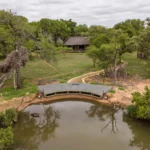Twitcher’s Guide to the Timbavati
For birding enthusiasts, the Timbavati Private Nature Reserve, nestled within the Greater Kruger National Park, is a true paradise. This region is home to a staggering 350+ recorded bird species, offering both beginner birdwatchers and seasoned twitchers an unforgettable experience. The Green Season from November to March is a particularly special time—many of our summer migrants are present, resident species are more active, and the lush post-rain landscapes provide a vibrant backdrop for birding safaris.
Join us for a deep dive into the colourful world of birding in the Timbavati.
An Introduction to Birding in the Timbavati
Birding in this part of the Lowveld is nothing short of spectacular. The diverse range of habitats—from riverine forests and open grasslands to mopane woodlands and seasonal pans—ensures that you’re never far from a remarkable sighting. Whether you’re scanning the treetops for a Verreaux’s eagle-owl or watching the flutter of a sunbird in the morning light, each day offers new surprises.
At Kings Camp, our experienced guides lead specialised birding safaris, tailoring each drive to guests’ interests. From casual birders seeking colourful and charismatic species to hardcore twitchers after that elusive lifer, we cater to all levels of experience.
Birding in the Green Season
The Green Season (November to March) is a paradise for birdwatchers in the Timbavati and the Greater Kruger region. With the summer rains replenishing the landscape, the bush is at its most vibrant, creating the perfect conditions for an influx of migratory species from Europe, Asia, and other parts of Africa. These seasonal visitors, combined with a diverse array of resident birds, make this time of year particularly rewarding for birding. The abundance of food encourages birds to be more active, offering excellent viewing opportunities as they forage, hunt, and interact in their natural habitat. From colourful kingfishers and bee-eaters to powerful raptors and owls, every game drive or bush walk presents a chance to spot something extraordinary.
The breeding season is also in full swing, adding an extra layer of excitement to birdwatching during this time. Many species are adorned in brilliant breeding plumage, making them easier to identify and a dream to photograph. This is also when fascinating courtship displays take place, from the elaborate aerial acrobatics of raptors to the intricate nest-building of weavers. Whether you’re a dedicated birder or simply enjoy the beauty of the bush, the Green Season offers an immersive and dynamic birding experience, where every sighting tells a story of survival, adaptation, and natural wonder.
Common Sightings: Iconic Birds of the Lowveld
Some birds are simply synonymous with the African bush, and in the Timbavati, they’re part of the daily experience:
- Lilac-breasted Roller – A firm favourite among guests, this bird’s brilliant mix of blues, greens, and purples makes it one of the most striking species in the bush. They are often seen perching on branches, scanning for insects before putting on an acrobatic aerial display.
- Southern Yellow-billed Hornbill – Often nicknamed the “flying banana” due to its large yellow beak, this curious bird is commonly found foraging along the ground or calling loudly from treetops.
- Burchell’s Starling – With its iridescent blue-green plumage, this striking starling is frequently spotted in small family groups, flashing metallic hues as they dart between trees.
- Grey Go-away Bird – Named for its distinctive “go-away” call, this bird is often seen in small flocks feeding on fruits or perching conspicuously in trees.
- Helmeted Guineafowl – These speckled game birds roam in noisy flocks, often seen foraging along roads or dashing into the undergrowth at the first sign of danger.
- African Fish Eagle – The unmistakable call of this striking raptor, often heard near water sources, is a quintessential sound of Africa.
- Woodland Kingfisher – Easily identified by its electric blue wings and distinctive chattering call, this summer migrant is a common sight in the warmer months.
Bucket List Birds: Special Sightings for Serious Twitchers
For avid birders, the Timbavati presents a chance to tick off some truly special species—birds that are rare, elusive, or simply breathtaking:
- Pel’s Fishing Owl – A prized sighting for any birder, this large, tawny-orange owl is a secretive resident of riverine forests, best spotted at dawn or dusk near water sources.
- Pennant-winged Nightjar – An ethereal bird that migrates into the region during summer, the male’s long, trailing wing feathers create an unforgettable sight during its display flight.
- Kori Bustard – The heaviest flying bird in the world, this ground-dwelling giant is often found in open grasslands, slowly striding as it forages.
- Arnot’s Chat – A highly sought-after species that thrives in mature mopane woodlands, this striking black-and-white bird is a must-see for serious birders.
- Southern Ground Hornbill – Listed as vulnerable, these large, red-faced birds are an iconic presence in the Lowveld. Their deep, booming calls can be heard in the early mornings as they move in small family groups.
- Martial Eagle – Africa’s largest eagle, this powerful predator is a thrilling sight as it soars overhead or perches atop tall trees scanning for prey.
- Harlequin Quail – A well-camouflaged ground bird that is notoriously difficult to spot, but a fantastic addition to any serious birder’s list.
Best Time to Go on a Birding Safari in The Timbavati
While birding is rewarding year-round, the Green Season (November to March) is peak time for serious birders. The summer rains bring an influx of migratory species from Europe, Asia, and beyond, vastly increasing the variety of birds to be seen. This is also when many species display their brightest breeding plumage, making them easier to identify and a dream to photograph.
Top tips for birding safaris:
📌 Early mornings and late afternoons are prime birdwatching times, as this is when birds are most active.
📌 Bring a good pair of binoculars (8×42 or 10×42) for the best viewing experience.
📌 A reputable bird field guide or an app like Roberts or Sasol eBird can be invaluable.
📌 Don’t forget a camera with a zoom lens—the Timbavati offers fantastic bird photography opportunities!
Birding from Kings Warren Wildlife Hide
For birding enthusiasts seeking a unique and immersive experience, Kings Warren Wildlife Hide offers an unparalleled vantage point. Nestled on the edge of a well-frequented waterhole, this underground hide provides exceptional opportunities to observe and photograph birds up close without disturbing their natural behaviour.
The hide is specially designed with imported one-way photographic glass, allowing guests to capture stunning images while remaining unseen by the wildlife. With adjustable viewing windows and comfortable seating, birders can spend hours watching a diverse array of species come and go. From kingfishers darting over the water to storks, herons, and various raptors swooping in for a drink, the hide is a must-visit for both seasoned photographers and casual birdwatchers alike.
Birding in the Winter Months
Even in the dry winter months (May to August), birding in the Timbavati remains an exciting and rewarding experience. As the seasonal waterholes dry up, birds concentrate around permanent water sources, making it easier to spot a variety of species in one location. The sparse vegetation of winter provides excellent visibility, allowing for unobstructed views of both large raptors soaring overhead and smaller species flitting between the branches. With the migratory birds having departed, the focus shifts to resident species, such as hornbills, barbets, and kingfishers, which remain active throughout the year.
One of the highlights of winter birding is the increased raptor activity. With fewer food sources available, birds of prey such as martial eagles, African hawk-eagles, and brown snake eagles become more visible as they scan the open plains for prey. Owls, including the giant eagle-owl and the pearl-spotted owlet, can often be seen perched on bare branches during the day or heard calling at dusk. The cooler temperatures also make for comfortable bird watching excursions, whether from a game vehicle, a walking safari, or the Kings Warren Wildlife Hide, where water-dependent species like storks, herons, and water thick-knees gather.
While winter may lack the bright breeding plumage and high energy of the Green Season, it offers a different, more focused birding experience, where patience is rewarded with rare and intimate sightings of the region’s incredible avian life.
A specialised birding safari at Kings Camp is the ultimate way to experience the rich birdlife of the Timbavati. Expert field guides, equipped with in-depth knowledge of bird calls, habits, and movements, can help you identify and appreciate everything from common species to once-in-a-lifetime rarities.
Whether you’re a casual birdwatcher enjoying the symphony of the bush or a dedicated twitcher with a specific list in mind, Kings Camp offers an unrivalled birding experience.
📍 Book your specialized birding safari today!





